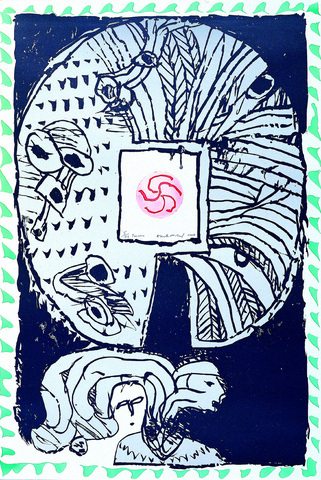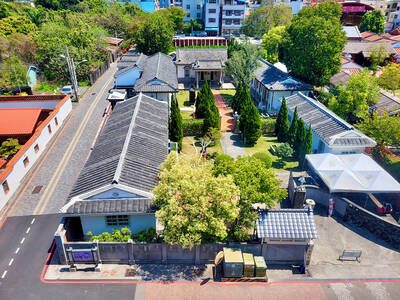As Taipei's alternative art spaces are disappearing and many galleries are feeling the pinch from the lackadaisical art market, the Taipei Fine Arts Museum proves to be the only place in town that consistently holds art exhibitions that are provocative, informative, educational and entertaining.
One such show is the in-house exhibition titled Depictions in Line and Form that combines its collection of Western and Eastern artwork on view until May 1.
Looking at the works from a distance, it is impossible to tell who had the larger influence. Were Western artists embracing Asian calligraphic styles when they were creating Modernist works or were Asian artists emulating European and American styles of painting? Instead of trying to resolve this conundrum, this display of paintings, prints and a few sculptures from the museum's vast collection provides a wonderful opportunity to see pure line and form in art.

PHOTO COURTESY OF TFAM
In most of the works, the artist's energy and vitality is expressed through the line that is hand-drawn, etched, brushed or sculpted in the various media. The line in all its various permutations -- curvy, biomorphic, angular, thick, thin, geometric or sketchy -- conveys emotional intensity and may inspire the viewer to return home and pick up a brush.
Often, categories of art seem arbitrary. For didactic purposes, the exhibition is divided into four categories: "Tumultuous Worlds," "Traces in Time and Space," "Primal Nature" and "Urban Energy." The categories are a way to help the viewer decipher and try to understand the abstract lines and shapes on view.
Tumultuous Worlds
Grouped under the theme "Tumultuous Worlds," a set of four small-framed woodcuts by Jean Hans Arp sets the tone for the Modernist-style works that are arranged in the cavernous space. Arp's white curvy lines dance on a black background, creating a piece that is simultaneously playful, intimate and sensuous.
Renowned Taiwanese artist Max Liu (
Pierre Alechinsky's series of lithographs titled Fenetre really stand out in the exhibition. As lithography is a slow process entailing several steps, this work is noteworthy in that the artist's hand-drawn lines with a dark grease pencil still seem immediate and freshly made. It is a work where the lusciousness of the material is conveyed very passionately.
Traces in Time and Space
Works that show motion are grouped under the theme "Traces in Time and Space." The famous Chinese artist Hsia Yang's (
Italian artist Lucio Fontana is known for his reductive canvases made in the early 1960s in which he slashed the surfaces with a knife, thus creating cut-away lines. It was controversial at the time to treat such a sacred surface as the artist's canvas with such violent gestural aggression.
Primal Nature
More of the calligraphic and loosely painted works are grouped under the theme "Primal Nature." Kaoshiung-based artist Lu Ming-te (盧明德) shows Tatu Mountain, a collage of paint and twigs on fabric. A marble sculpture of a mythic beast that is half lion and half female by Pierre Sz'kely exemplifies the theme.
Urban Energy
Works whose combinations of lines create a strong vortex of feeling are grouped under "Urban Energy." Michell Hwang's Dignity is an acrylic painting on a cut-out piece of wooden board that resembles a winter sled designed especially for the Abstract Expressionist painter, as curvy, expressive lines and bright color lend a lot of energy to the oddly-shaped piece.
Swallow Lin's (
Exhibition notes:
What: Depictions in Line and Form at the Taipei Fine Arts Museum
Where: Taipei Fine Arts Museum, 181, Zhongshan N Rd, Sec 3, Taipei (
When: Until May 22; Tuesdays to Sundays, 9:30am to 5:30pm

In the March 9 edition of the Taipei Times a piece by Ninon Godefroy ran with the headine “The quiet, gentle rhythm of Taiwan.” It started with the line “Taiwan is a small, humble place. There is no Eiffel Tower, no pyramids — no singular attraction that draws the world’s attention.” I laughed out loud at that. This was out of no disrespect for the author or the piece, which made some interesting analogies and good points about how both Din Tai Fung’s and Taiwan Semiconductor Manufacturing Co’s (TSMC, 台積電) meticulous attention to detail and quality are not quite up to

Chinese Nationalist Party (KMT) Chairman Eric Chu (朱立倫) hatched a bold plan to charge forward and seize the initiative when he held a protest in front of the Taipei City Prosecutors’ Office. Though risky, because illegal, its success would help tackle at least six problems facing both himself and the KMT. What he did not see coming was Taipei Mayor Chiang Wan-an (將萬安) tripping him up out of the gate. In spite of Chu being the most consequential and successful KMT chairman since the early 2010s — arguably saving the party from financial ruin and restoring its electoral viability —

It is one of the more remarkable facts of Taiwan history that it was never occupied or claimed by any of the numerous kingdoms of southern China — Han or otherwise — that lay just across the water from it. None of their brilliant ministers ever discovered that Taiwan was a “core interest” of the state whose annexation was “inevitable.” As Paul Kua notes in an excellent monograph laying out how the Portuguese gave Taiwan the name “Formosa,” the first Europeans to express an interest in occupying Taiwan were the Spanish. Tonio Andrade in his seminal work, How Taiwan Became Chinese,

Toward the outside edge of Taichung City, in Wufeng District (霧峰去), sits a sprawling collection of single-story buildings with tiled roofs belonging to the Wufeng Lin (霧峰林家) family, who rose to prominence through success in military, commercial, and artistic endeavors in the 19th century. Most of these buildings have brick walls and tiled roofs in the traditional reddish-brown color, but in the middle is one incongruous property with bright white walls and a black tiled roof: Yipu Garden (頤圃). Purists may scoff at the Japanese-style exterior and its radical departure from the Fujianese architectural style of the surrounding buildings. However, the property